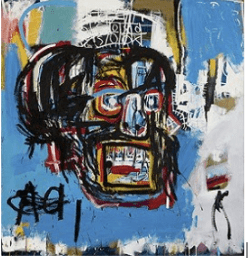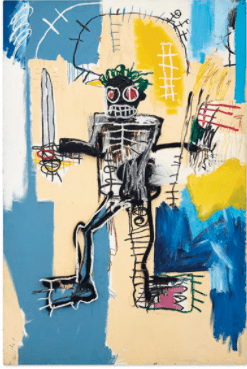Lakshmi Sajith, On Jean-Michael Basquiat
The first time I looked at Jean-Michael Basquiat’s work I was not impressed. All I could see was work I could’ve done at 7 years old. Where was the use of technical skills that famous artists were known for? Well, it was all there just not as obvious as other work, which now to me makes it even more impressive.
Basquiat grew up in New York City, showing talent for artistic ventures at a young age. His mother, supporting his interest, took him to museums and other exhibitions. However, the event that shaped his career was his removal of his spleen. As a young boy, Basquiat was met with a severe car accident in which he was in critical need of surgery. After undergoing this procedure, Basquiat read the famous medical book, Gray’s Anatomy, deeply influencing his artistic style.
To see Basquiat’s work, there was no need to purchase a museum ticket. They could be found on New York City buildings, getting plenty of media attention. As time went on and the Neo-expressionist movement came into the west, Basquiat’s work grew more popular.
Though his work seemed messy, he often spoke to the issues of classism and racism with images and texts in his work. The unprofessional-looking style of Basquiat’s work was the child of several traditions, practices, and styles from his city environment and Afrcian-Carribean heritage.
One of his most renowned works, Untitled 1981, is a piece many mistook for simple. Yet with the outlook of artistic decisions, his work becomes all the more complicated, filled with layers that come with an overload of questions. To create the chaos, Basquiat concocts jumbled parts of teeth, flesh, and hair with the use of different mediums of colored pencil and acrylic paint.
In learning that this piece is a self portrait, it’s easy to be confused as to why it’s so prominent in the art world. It’s not realistic nor pretty. It’s with Basquiat’s mastered use of controlled chaos that makes him so significant. He shows that art doesn’t have to be about rendering a subject exactly or creating something pleasing to the eye. His work was more focused on the subliminal information and emotion a viewer would derive from his pieces rather than aesthetics. This is why studying Basquiat allows artists, including myself, to mature and see past the first layer.

Untitled, 1982, Jean-Michael Basquiat
In his piece, Warrior, 1982, Basquiat portrays a warrior with a sword in a position ready to attack. Although at this point in his career, he was painting on material other than public walls, there were still a lot of shared similarities including rawness.

Warrior, 1982, Jean-Michael Basquiat
Another factor in his prominence was his personality. Basquiat went on to become a cultural icon with collections in Supreme and Urban Outfitters. Unfortunately due to heroin overdose, Basquiat passed away only 6 years after his first art show.
As years went on, his work became more recognized and influential. His work continues to be the reason that I make the artistic choices I do today.
Works Cited
ArtLife. “Why Is Jean-Michel Basquiat so Famous?” ArtLife, 13 May 2021, www.artlife.com/why-is-jean-michel-basquiat-so-famous/.
“The Jean-Michel Basquiat i Knew…” The Guardian, Guardian News and Media, 3 Sept. 2017, www.theguardian.com/artanddesign/2017/sep/03/jean-michel-basquiat-retrospective-barbican.
Person. “Basquiat’s Warrior – the Most Valuable Western Artwork Ever Offered in ASIA: CHRISTIE’S.” Jean-Michel Basquiat’s Warrior at Christie’s | Christie’s, Christies, 12 Mar. 2021, www.christies.com/features/Jean-Michel-Basquiats-Warrior-at-Christies-11528-3.aspx.